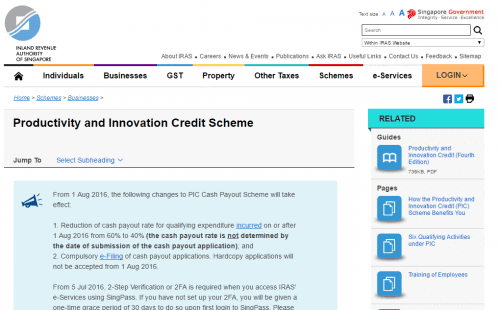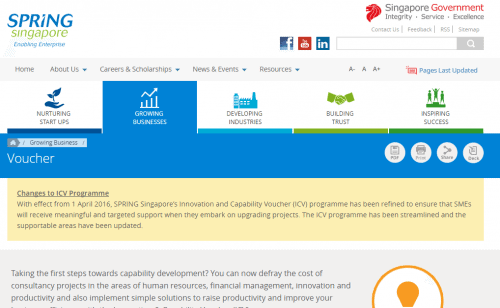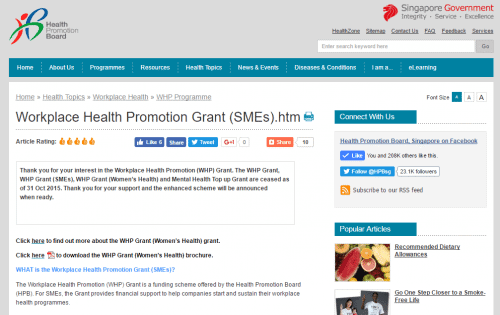Over the course of years running my own business, I have learned to tap on the myriad of government funding and grants that are available.
It started way back in 2008 when we tap on LETAS (otherwise known as the Local Enterprise Technical Assistance Scheme).
The purpose of this grant is to offset the cost of engaging external consultants to implement quality management and IT systems.
For us, this included ISO certification and upgrading of computer systems. Up to 50% of the expenses of hiring the consultant can be subsidised.
We used that to put in place a recruitment CRM system after four years of using Outlook as our primary source of database.
That helped us to increase our productivity as we now can share and access a centralised pool of resumes in a single depositary.
LETAS has since been phased out.
But there are many others that one can tap on.
An excellent portal to find out all about them would be http://www.waytogo.sg/.
There are more than one hundred different grants & subsidies you can refer to.
Mind-boggling yes.
For those that are starting to explore this, let me point out a few that are good “beginners” grants.
These are subsidies that are easy to apply, relevant to every workplace and could be implemented without reading an entire manual.
Usually, at this point, I will hear commentators about working on the business instead of focusing on the grants. My response is why not do both.
In sharing this information, I am not implying that one should just stop all business activities and innovations.
Know that these grants are there for all to apply.
If all your competitors are already doing so, you might as well do it too to put yourself on an even playing field.
Moreover, the grant application process is usually one-off.
For every one of them here, you won’t need more than 30 minutes to fill up the necessary forms.
For a couple, the vendor does the form-filling for you.
1. Productivity and Innovation Credit (PIC)
The Productivity and Innovation Credit (PIC) scheme supports investments in Productivity and Innovation. Businesses, including sole proprietors, can enjoy tax savings in the form of Cash Payout and/or Tax Deduction and receive a PIC Bonus when they invest in any of these six productivity improvement activities.
Two of them would be relevant to any businesses you are running – Training of Employees and Acquisition or leasing of IT and Automation Equipment.
This is a pre-approved grant, so there is no form to fill up beforehand. You just have to ensure the items you wish to spend on is recognised under PIC’s framework.
For me, I applied it to external training programs to upskill the employees.
This can even be implemented into heavily discounted WSQ programs that you can couple with Absenteeism payroll under Skills Development Fund.
Adoption of new technologies is also applicable. Getting new hardware and even cloud computing are pre-approved.
In my case I used it to adopt cloud VOIP, laptops, migrate to a cloud recruitment CRM and upgrading our network infrastructure with better switches and routers.
You can either choose for a 400% tax deductions/ allowances or a 60% cash payout.
[callout]With effect from 1 Aug 2016, the Productivity and Innovation Credit (PIC) cash payout rate will be at 40% instead of 60% of qualifying expenditure subject to a total cost cap of $100,000 across the six qualifying activities. The other PIC component of 400% tax deduction on up to $400,000 of spending per year in each of the six activities remains unchanged. The PIC Scheme will expire after Year of Assessment (YA) 2018. [/callout]
The application is real easy. You just enter an online form every quarter and submit via IRAS website.
Make sure the elements are qualified. Don’t take your chance on this as it will result in reimbursements delay.
The maximum you can get back it $60,000 over a financial year.
2. WorkPro
WorkPro aims to provide funding support for employers and employees through two key strategies:
to help companies improve their workplace practices and enhance work-life harmony,
and to attract and retain back-to-work locals, as well as mature workers.
Employers will receive a broad range of assistance to implement work-life measures and redesign jobs.
Employers will also receive incentives when they recruit mature workers and back-to-work locals or place their employees on flexible work arrangements (FWAs).
WorkPro started off as WoW! Fund in 2008. It became WorkPro when it was decided to combine WoW! Fund with Advantage Re-Employment scheme.
Under the plan, laptops replaced the old desktops to facilitate telecommuting, and flexible working policies were put in place (supported by attendance tracking system).
Until today I would say this is the best funding that was tapped on.
The flexible working arrangement helped tremendously in positioning the company to be an employer of choice.
It helped when I’m selling the company across to job seekers and in retaining the existing ones as everyone no longer need to clock in/out for the sake of it.
Under WorkPro, you need to engage NTUC or SNEF to help with the application.
One good thing about WorkPro would be the Work-Life Grant component.
It provides up to $160k of incentives (not reimbursements) to help companies:
- Implement a Flexible Work Arrangement (FWA) Pilot (to test it out and make sure it works for you)
- Formalise the FWA into your HR policies (and make it permanent fixtures in your HR processes)
The process can be complicated. It is best to engage an Approved Work-Life Consultant to help with the entire process.
Moreover, you can claim up to 80% of the Consultancy cost from MOM.
3. Innovation & Capability Voucher
The Innovation & Capability Voucher (ICV) is a simple to apply, easy-to-use voucher valued at $5,000, to encourage SMEs to take their first step towards capability development.
SMEs can use the coupon to upgrade and strengthen their core business operations through consultancy in the areas of innovation, productivity, human resources and financial management.
Apart from consultancy, ICV also supports SMEs in the adoption and implementation of simple solutions to improve business efficiency and productivity.
SMEs can use the ICV to implement productivity solutions under the supportable cost categories of
(i) equipment & hardware, (ii) technical solutions & training, (iii) design & renovation. Each SME is entitled to a maximum of eight vouchers.
For a business that is still functioning very much without any structure and processes in place, this is a quick way to scale up the ladder by a few notch.
Seasoned consultants will help you put these in and provide best-practice toolkits and templates to help you administer them in the future.
Along the way, ICV was improved and included productivity solutions.
So you can now tap on the vouchers to pay for renovation costs to maximise space planning or implement a direct marketing strategy by offsetting the cost of setting up a business MailChimp account.
When I first know this, there appears to be overlap between some parts of ICV and PIC.
Further understanding reveals there are none. ICV focuses on the implementation cost while PIC touches on recurring.
Make sure you have the quotation ready and justify with a strong reason why your expenditure will improve productivity significantly.
4. Workplace Health Promotion Grant (Ceased as of 31 Oct 2015)
What’s the point in securing all the grants if your employees are too sickly to turn up for work and use them?
The Workplace Health Promotion (WHP) Grant is a government funding scheme offered by the Health Promotion Board (HPB).
The Grant provides financial support to help organisations start and sustain their workplace health programmes.
You can do it yourself or get a consultant to help with your application.
This grant has allowed us to provide medical screenings, gym passes, bowling, futsal, basketball, badminton, archery, etc. all for free or mostly free.
It allowed us to have a budget to get our people together and mingle at a personal level.
Really useful when you are trying to build a culture.









